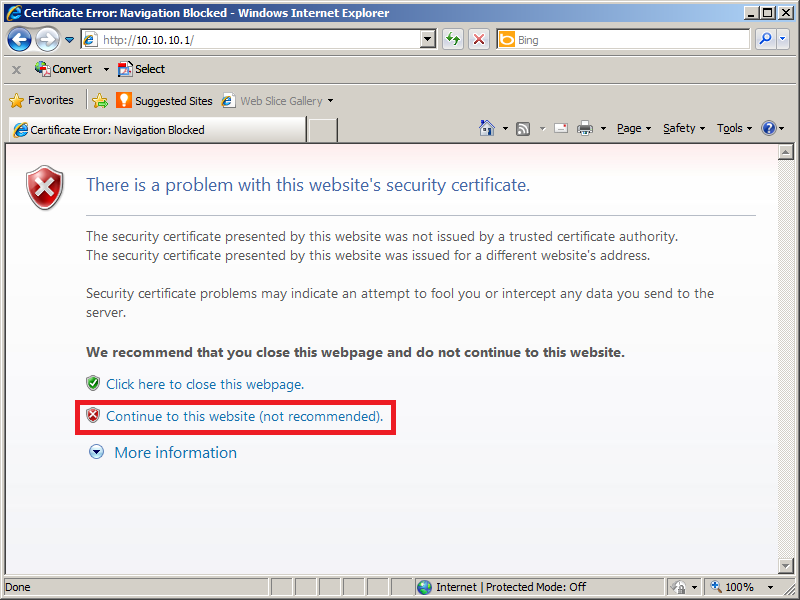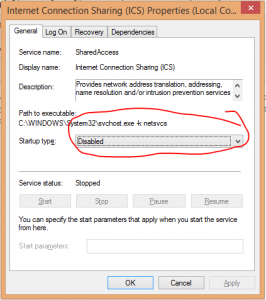Я пытаюсь подключиться к VPN на своем рабочем месте, но Cisco AnyConnect не работает после запуска соединения. Появляется ошибка с сообщением The VPN client failed to establish a connection , после чего появляется другая ошибка: AnyConnect was not able to establish a connection to the specified secure gateway. Please try connecting again. Я все пробовал. Переустановка, перезапуск и другие другие функции, такие как отключение ICS (общий доступ к подключению Интернета). Я попробовал это на своем ноутбуке, и веб-установщик работал нормально. Он установил клиента и подключился отлично, так что это должно быть что-то с этим ПК. Я пытаюсь понять это примерно в течение 5 часов, и Google не помогает. Вот история сообщений от AnyConnect:
Cisco VPN gives your employer (or your administrator) option to leave default 'split horizon' option (packets to company's servers go through VPN, packets to the Internet go straight), or disable it (everything goes through VPN and company's proxy, firewall etc.). This is done via local routing table manipulation. As per the suggestion, went to Control Panel- Network and Internet - Network and sharing center But could not find the Cisco AnyConnect secure mobility client connection. Here’s the message ffrom the the cisco anyconnect client ver 4.3.03xxx on Windows10 11:47:31 PM Contacting xxx country 11:47:32 PM Posture Assessment: Required for access. Cisco AnyConnect Secure Mobility Client VPN User Messages, Release 3.1 October 15, 2012 The following user messages appear on the AnyConnect client GUI. A description follows each message, along. Temporarily disable your Cisco AnyConnect Secure Mobility Client by following these steps: From Windows Start, select Run and type msconfig.exe in the Run box. This will run the System Configuration app. In the System Configuration dialog box, select the Startup tab. For Windows 7, deselect Cisco AnyConnect Services.
[11/11/2013 1:55:55 PM] Ready to connect. [11/11/2013 1:57:05 PM] Contacting —.—.—.— [11/11/2013 1:57:07 PM] Please enter your username and password. [11/11/2013 1:57:08 PM] User credentials entered. [11/11/2013 1:57:08 PM] Establishing VPN session. [11/11/2013 1:57:09 PM] Checking for profile updates. [11/11/2013 1:57:09 PM] Checking for product updates. [11/11/2013 1:57:10 PM] Checking for customization updates. [11/11/2013 1:57:10 PM] Performing any required updates. [11/11/2013 1:57:15 PM] Establishing VPN session. [11/11/2013 1:57:15 PM] Establishing VPN — Initiating connection. [11/11/2013 1:57:16 PM] Disconnect in progress, please wait. [11/11/2013 1:57:29 PM] Connection attempt has failed. [11/11/2013 1:59:31 PM] Ready to connect.
Я попытался отключить брандмауэр и антивирус. Я не думал, что это будет иметь значение, поскольку мой ноутбук использует тот же брандмауэр и антивирус, и мне не нужно было его отключать. Мой ноутбук использует Windows 7 Home 64-bit, а мой компьютер с ошибкой использует 64-разрядную версию Windows 7 Ultimate.
6 ответов
Решением для меня было отключить общий доступ к подключению Интернета (ICS).
Чтобы устранить эту проблему:
- Нажмите кнопку Windows Start .
- Нажмите Control Panel .
- Установите View by: в Category .
- Нажмите View network status and tasks в Network and Internet .
- Нажмите Change adapter settings .
- Найдите Shared в столбце Status и щелкните его правой кнопкой мыши и нажмите Properties .
- Перейдите на вкладку Sharing .
- Снимите флажок Allow other network users to connect through this computer’s Internet connection .
- Нажмите OK .
- Переустановите Cisco AnyConnect.
Я вижу, что отключение ICS не работало для OP, но это работало для меня и многих других, по мнению различных форумов, кажется.
Это может быть проблема с ThinkPad. Lenovo опубликовала рекомендательную статью , указывающую, что их программное обеспечение Access Connections мешает AnyConnect. Решение состоит в отключении ICS. У меня нет способа установить, является ли это фактической причиной моей проблемы, но решение работает.

Cisco Anyconnect Blocking Internet Access
ответ Натана на этой странице не работал для меня, потому что флажки Allow other network users[. ] были очищены для всех все равно.
Я отключил ICS таким образом:
Введите services.msc в меню Windows после нажатия кнопки «Пуск». Щелкните правой кнопкой мыши на services.msc , который появляется после завершения поиска, и Run as Administrator.
Найдите Internet Connection Sharing , остановите его и установите для запуска Manually .
KB ID 0001279В DtdВ 31/01/17
Problem
We had a firewall fail at work this week, as part of the rebuild the latest OS was put on it, version 9.7(1). I thought no more about it until I tried to VPN in and got this;
I used my Windows 10 VM and that connected fine, only my MacBook could not connect, this VPN tunnel is a big deal I need it to get onto client’s networks. I tried my other VPN connections and every one was fine, only the recently rebuilt one didn’t work? Ive seen OSX throw a wobbly with AnyConnect in the past so I did a complete uninstall, В deleted the opt/cisco folder and put on the latest version (4.4.00243 at time of writing) no change.
Connection attempt has failed due to server communication errors. Please retry the connection
A look in the client message history showed me this.
No valid certificates available for authentication.
I checked my certificates, and the certificate on the firewall both they, (and the certificate chain,) were fine.
Debugging AnyConnect gave NO OUTPUT at all, but debugging SSL showed me this;

Try Googling that and getting a result! In fact that’s probably what brought you here.
Solution
If you change a Cisco OS and things like this stop working normally it’s because they’ve dropped support for something that’s got a security hole in it. In the wake of the Poodle Exploit I assumed it was an SSL/TLS problem, but that wasn’t it.
I was in the right ball park though, and a bit of lateral thinking and SSL cipher problems I’ve had with ASDM, made me think, what if it’s SHA that’s been dropped because everyone is dropping SHA1 cause it’s the hashing algorithm of Satan?
Well as soon as I added a SHA1 ciphers back in, everything started working again!
Disclaimer: SHA1 is bad, where practical all cert ciphers should be at least SHA256
» means nesting-related): — Failed at: @displayUserCertifications user_id [in template «custom.author-acclaim-certifications» at line 4, column 9] ——>
- Mark as New
- Bookmark
- Subscribe
- Mute
- Subscribe to RSS Feed
- Permalink
- Email to a Friend
- Report Inappropriate Content
Hi all, I’m very new in AnyConnect and I’m doing something wrong.
If I navigate to https://myIP I can successfully log into the portal, download and install the AnyConnect Client and also CONNECT to the VPN.
But if I disconnect to the VPN, and try to login again through the try icon, I get a «connection attempt has failed».
So the only way I have to connect again is to navigate another time to the web portal and then, after login again, the VPN connection is successfully done.
Thanks for your help! Adobe professional 7 keygen.
» means nesting-related): — Failed at: @displayUserCertifications user_id [in template «custom.author-acclaim-certifications» at line 4, column 9] ——>
- Mark as New
- Bookmark
- Subscribe
- Mute
- Subscribe to RSS Feed
- Permalink
- Email to a Friend
- Report Inappropriate Content
Glad you worked it out. Please consider marking as answered and rating helpful post so this can be useful to others who may run into the same issues.

If this posts answers your question or is helpful, please consider rating it and/or marking as answered.
» means nesting-related): — Failed at: @displayUserCertifications user_id [in template «custom.author-acclaim-certifications» at line 4, column 9] ——>
- Mark as New
- Bookmark
- Subscribe
- Mute
- Subscribe to RSS Feed
- Permalink
- Email to a Friend
- Report Inappropriate Content
Are you using a Router or ASA has the VPN gateway? If you are using an ASA, check your DAP policy under Configuration, Network (Client) Access, Dynamic Access Policies. If there are policies there, chose the profile that is mapped to the tunnel you are connecting too and then go to «Access Method». Ensure «Web Portal» isn’t checked. If you want to be able use the portal and the client, you need to change it to one of the «Both» choices. If there is no DAP, we’ll have to dig a little deeper.
If this posts answers your question or is helpful, please consider rating it and/or marking as answered.
» means nesting-related): — Failed at: @displayUserCertifications user_id [in template «custom.author-acclaim-certifications» at line 4, column 9] ——>
- Mark as New
- Bookmark
- Subscribe
- Mute
- Subscribe to RSS Feed
- Permalink
- Email to a Friend
- Report Inappropriate Content
Hello Christopher, thanks for your answer.
I’m using an ASA, and in DAP I only have the DfltAccess, and I changed the Access Method from Unchanged to Both, but I have the same problem.
Now I have a question (sorry if it is obvious), using the portal, I provide the login/passwd, but using only the client it doesn’t ask me for credentials, it only shows the certificate error (cause it is self-signed), and when I accept it, the connection fails.
» means nesting-related): — Failed at: @displayUserCertifications user_id [in template «custom.author-acclaim-certifications» at line 4, column 9] ——>
- Mark as New
- Bookmark
- Subscribe
- Mute
- Subscribe to RSS Feed
- Permalink
- Email to a Friend
- Report Inappropriate Content
When you go to login through the AC client, what is in the «Connect To:» box? It may be an issue regarding the AC profile that gets downloaded after successfully logging in and downloading the client via web portal.
**Please remember to rate helpful posts as well as mark the question as ‘answered’ once your issue is resolved. This will help others to find your solution faster.
» means nesting-related): — Failed at: @displayUserCertifications user_id [in template «custom.author-acclaim-certifications» at line 4, column 9] ——>
- Mark as New
- Bookmark
- Subscribe
- Mute
- Subscribe to RSS Feed
- Permalink
- Email to a Friend
- Report Inappropriate Content
Hi, in the connect To box there is the public IP of the ASA, so I think it might be correct. Then appears an Untrusted VPN Certificate warning, and after clicking «Connect Anyway» it shows the error.
I have the anyconnect-win-3.1.04063-k9.pkg client software, should I try a lower version?
Maybe I’ll try to create the certificate through a Windows Server CA and then import to ASA and to the client, so see if it solves the issue.
» means nesting-related): — Failed at: @displayUserCertifications user_id [in template «custom.author-acclaim-certifications» at line 4, column 9] ——>
- Mark as New
- Bookmark
- Subscribe
- Mute
- Subscribe to RSS Feed
- Permalink
- Email to a Friend
- Report Inappropriate Content
First try this. Open the AnyConnect Client, go to the Preferrences tab, and make sure the box that says «Block Untrusted Servers» is NOT checked.
If this posts answers your question or is helpful, please consider rating it and/or marking as answered.

» means nesting-related): — Failed at: @displayUserCertifications user_id [in template «custom.author-acclaim-certifications» at line 4, column 9] ——>
Cisco Anyconnect Blocks Internet Windows 10
- Mark as New
- Bookmark
- Subscribe
- Mute
- Subscribe to RSS Feed
- Permalink
- Email to a Friend
- Report Inappropriate Content
Hi Christopher, that was the first I have to do in order to be able to connect when I connect to the VPN (through the web) for the first time. So I can confirm it is unchecked.
Thanks for the advice
» means nesting-related): — Failed at: @displayUserCertifications user_id [in template «custom.author-acclaim-certifications» at line 4, column 9] ——>
- Mark as New
- Bookmark
- Subscribe
- Mute
- Subscribe to RSS Feed
- Permalink
- Email to a Friend
- Report Inappropriate Content
Cisco Anyconnect Blocking Internet
Do you have access to ASDM or a syslog server? It would be best if you could grab the exact error message in the logs when you try to connect.

Also, if you are using ASDM — make sure you have «Enable Cisco AnyConnect VPN Client Access on the intefaces in the table below» checked. Assuming you are using the «outside» interface, check that one and enable DTLS. Then click «Device Certificate» and make sure you have the correct certificate chosen for the SSL connection (probably the ASAs self signed certificate».
Make sure «Bypass interface access lists for inbound VPN sessions» is checked as well.
If this posts answers your question or is helpful, please cons />
Похожие записи:
